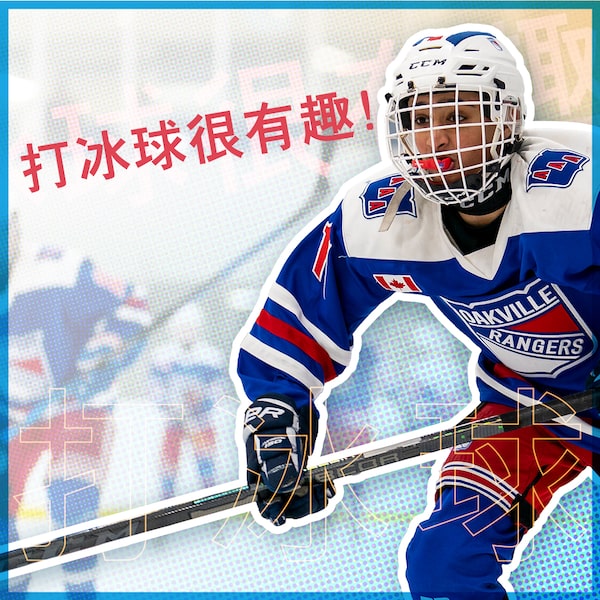Stars and the Wild players play ball hockey during the Rising Stars division quarter finals, at the Scarborough Muslim Ball Hockey Association tournament, in Toronto, Sunday Sept. 24, 2023.Christopher Katsarov/The Globe and Mail
In August, the Ontario Minor Hockey Association launched a registration drive that, for the first time, featured targeted ads in Chinese and Punjabi.
The largest minor hockey association in the world had a very simple reason for never doing anything of the sort in the past.
“We’ve never had to,” says Ian Taylor, executive director of the OMHA.
But with registration in decline, demographics changing across the country and many ugly incidents that threaten to define the sport in many peoples’ eyes, everyone agrees new approaches are necessary, Taylor says. “There’s been a reckoning.”
Participation rates were already declining before the pandemic, which decimated the sport. In the more than three years since lockdowns began, incidents of racism, homophobia and the sexual-assault scandal at Hockey Canada have marred the game.


In August, the Ontario Minor Hockey Association launched a registration drive that featured targeted ads in Chinese and Punjabi.Ontario Minor Hockey Association/OMHA
In response, leagues and associations across the country have been taking steps to change the culture of the sport and reach out to communities which, in the past, may not have felt welcomed or interested.
It remains to be seen whether this year is another low point on a downward trajectory or a much-needed turning point. But one thing everyone agrees on is that the importance of the season ahead – for revitalizing hockey and rehabilitating its reputation – cannot be overstated.
“It’s massive, it’s huge,” Taylor says.
Just more than 600,000 people were registered in amateur-hockey programs in the 2019-20 season, Hockey Canada says. That was 6 per cent lower than the previous year and the lowest registration rate in nearly a decade.
The following season, the pandemic chopped that number to below 400,000.
By the 2021-22 season, registrations had climbed to 521,300, but that was still nearly 15 per cent lower than two years prior.
There are many reasons for the decline. The costs and time required are significant. Changing demographics also play a role.
A Leger poll conducted earlier this year for the Association for Canadian Studies found that only 13 per cent of immigrants follow hockey more closely than any other sport. That put hockey slightly higher than basketball, at 10 per cent, but well below soccer, which 20.8 per cent of new Canadians follow most closely.
As well, multiple incidents of racism and homophobia in the sport in the past several years have garnered significant media attention, along with a sexual-assault scandal at Hockey Canada, which revealed that a lawsuit brought by a woman, who alleged she was the victim of a gang-sexual assault by members of the 2018 Canadian world junior team, was settled through a fund built by registration fees. As a result, the organization’s chief executive and entire board of directors stepped down and an independent third-party complaints process was created, among other reforms.
The impact of these events is difficult to measure, but they have surely turned many people away from the sport.
“We’d all be naïve to think that they didn’t have any impact,” says Scott Oakman, executive director of the Greater Toronto Hockey League (GTHL).
Abu Hafejee from the Scarborough Muslim Ball Hockey Association.Christopher Katsarov/The Globe and Mail
In 2004, Abu Hafejee’s father started a ball-hockey league for kids at the mosque he attended in Scarborough, in northeast Toronto.
“He grew up in an apartment building filled with Newfoundlanders and they loved the Habs. It was the late 1970s and early ‘80s and the Habs were kicking butt with Dryden and company so he became a big hockey fan,” says Hafejee, who eventually took over running the ball-hockey league from his father.
A carpenter who runs his own construction company, Hafejee is also a long-time referee in the GTHL.
In 2021, Hafejee was invited to join the league’s diversity committee.
It was there that he learned about First Shift, an introductory program for families new to hockey.
“I said, ‘Okay, I’ve got 100 kids who want to play ice hockey tomorrow,’ ” Hafejee told the group.
The First Shift program provides six weeks of training and gear provided by Bauer.
Hafejee called Ed Wahl, president of the Scarborough Hockey Association, who offered to provide coaches and promised to graduate any youth who wanted to move from the program to the SHA house-league program for free.
They also extended the program to 13 weeks in the hopes that more training would generate a greater interest in hockey.
Of the approximately 100 youths who participated, more than half have gone on to play house-league hockey, Hafejee says.
“It’s like opening a halal meat store in a Muslim community,” Hafejee says. “There’s this huge customer base here. There’s a huge Muslim ball-hockey community in Toronto. Massive. And there’s no connection with ice hockey. There’s no connection Hockey Canada has made. There’s no connection the GTHL has made – until now.”
Ed Wahl, president of the SHA Hockey Club and Scarborough Ice Raiders chats with Abu Hafejee at the Commander Park Arena, in Scarborough, on Sept. 23, 2023.Christopher Katsarov/The Globe and Mail
As it enters its second season, the program has approximately 80 kids from the ball-hockey league signed up, Wahl says.
“This is not a one-year wonder. This is going to be a continuous program that we run,” he says.
The success of the program is a good example of what leagues need to be doing to help the game grow, Oakman says.
“It is the best indication of hockey organizations understanding that they just don’t open the doors to the arena and people will come through them,” he says.
The ball-hockey program is exactly the sort of initiative Hockey Canada hopes to learn from and share with associations across the country, says Scott Furman, vice-president of growth and retention at Hockey Canada.
This fall, the organization will be piloting an interim platform called the Hockey Canada Innovation Exchange, which will allow people to share knowledge, best practices and success stories, Furman says.
“Growing the game can’t be a one-size-fits-all approach,” he says. “It needs to be respectful of what people value and the communities they live in. So it’s really critical that we begin to document, share and celebrate some of the initiatives and best practices that are being run out there.”
Hockey Canada is also considering “alternative delivery models,” to help reduce some of the traditional barriers to the sport, which may include shorter seasons and perhaps only one day of practice each week instead of several, Furman says.
Increasing the number of female players is also a top priority for Hockey Canada.
In the 2021-22 season, there were 88,141 registered female players, Hockey Canada data show. That’s down from 101,879 in the 2019-20 season, and less than 20 per cent of all players.
“It continues to be a priority and opportunity for us,” Furman says. “We want to make sure that women and girls of all ages have accessibility to the sport, have a positive experience and equity in things like ice time and other areas as well.”
There are early indications for optimism. As of late September, enrolment is up 18 per cent across Canada compared to the same time last year, Furman says.
“Obviously we have a long way to go,” he says. “But it’s a decent sign.”
Youth gather around and between schoolyard rinks where the Scarborough Muslim Ball Hockey Association hosts a series of games in several divisions, in Toronto on Sunday Sept. 24, 2023.
In the fall of 2021, Mark Connors, a teenaged goaltender from Nova Scotia, faced repeated racial slurs and taunts at a tournament in Prince Edward Island. Connors is Black.
The incident resulted in a 25-game suspension for five players.
In the aftermath of the incident, Hockey Nova Scotia adopted a code of conduct with a zero-tolerance policy for racism and discrimination in the game, says Dean Smith, chair of Hockey Nova Scotia’s diversity and inclusion task force.
“It’s key to growing the game that we access traditionally under-represented communities,” Smith says.
This season, Hockey Nova Scotia is launching a BIPOC hockey program for youth aged 11-15 to receive skill-development training, Smith says.
The organization will also continue its partnership with Queer Hockey Nova Scotia, begun last year during Halifax Pride, to hold a tournament in the city.
Efforts to reach out to diverse communities and reform hockey’s reputation are certainly needed for the game’s survival, says Taylor McKee, an assistant professor of sports management at Brock University.
“They’ve seen the writing on the wall. This isn’t necessarily about a changing world. It’s about a changed world. So the question is whether or not hockey is going to change up with it in time to save itself,” he says.
Youth watch the Stars and the Wild play ball hockey during the Rising Stars division quarter finals of the Scarborough Muslim Ball Hockey Association tournament on Sept. 24, 2023.Christopher Katsarov/The Globe and Mail
And while leagues and associations across the country have begun to champion diversity, equity and inclusion more, prospective players and families are still getting mixed messages from the game at its highest level, McKee says.
“Unfortunately, last year was perhaps one of the most retrograde years the NHL has had in the past decade,” he says.
McKee points to Ivan Provorov, the Philadelphia Flyers player who refused to wear a Pride Night jersey last January because of his religious beliefs.
Another five players, including three Canadians, said they, too, would not wear the jerseys following Provorov’s refusal.
Following the controversy, Provorov’s jersey sold out at the NHL Shop, the league’s online store.
In response to the conflict, the NHL said in June that players would no longer wear Pride jerseys, although teams will continue to host Pride nights.
How important this year is in saving the game is “the billion-dollar question,” McKee says.
“Do we need to consult the architects or do we still need the fire department? Are we trying to build something new or is the burning still going on?”
This season, BC Hockey has launched two new working groups – an equity, diversity and inclusion group and a safe-sport work group.
It has also launched a campaign called “Be the Change,” asking people to be the change in diversity, equality, accessibility, inclusion and leadership “on the bench” and “in the stands.”
“You’re signalling to everybody, this is what we’re all about,” says Cameron Hope, CEO of BC Hockey.
Sharks' Ibraheem Siddiqui and Kings' Huzaifa Motala compete for the ball during the juniors' league quarter final game of of the Scarborough Muslim Ball Hockey Association on Sept. 24, 2023.Christopher Katsarov/The Globe and Mail
The part hockey plays in addressing social ills has been a frequent topic of conversation the past few years among players, parents, coaches and officials, Hope says.
“There’s people in the ecosystem who say there’s a lot of societal problems out there and we can’t solve society’s problems. But that’s not true. If you’re the biggest game, if one of the big cultural touch points for a society is your game, you have that responsibility,” Hope says.
Addressing those problems isn’t just a matter of conscience; it’s one of survival for a sport that even without those problems is difficult for many people to play because of cost, time and access.
“If you’ve got that double whammy of a bad reputation for inclusion and barriers like that, your game’s finished,” Hope says.
 Dave McGinn
Dave McGinn